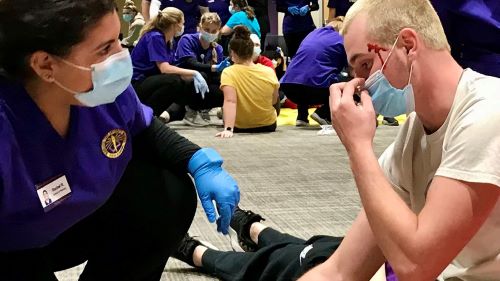Nursing students participate in mock disaster drill
Simulation helps prepare students for emergencies

School of Nursing students at Minnesota State University, Mankato participated in a mock disaster drill that had first-semester nursing students role playing as tornado victims and third-semester nursing students responding at the scene.
For the scenario, more than 50 first semester nursing students received mock injuries (called moulage) for the purpose of emergency response training.
Once the “victims” were ready, they arrived in a staged patient care area in waves, where the future nurses triaged them. Following an hour of simulated patient care, all students convened with faculty for a debrief.
Mock Scenario, Real Lessons
Prior to the simulation, the future nurses had no knowledge of the disaster they’d be dealing with or the types of patients they’d be seeing. They needed to – on the spot – figure out communication among themselves and determine the best way to treat patients.
There were broken bones, visible head wounds, panic attacks, a mother ready to deliver a baby, and people looking for loved ones. And, in keeping with the times, there was one patient planted in the group that was told to say she had Covid.
All scenarios – played out in a meeting room in the Centennial Student Union – provided an opportunity for reflection and discussion.
As a group, did they make the right choices in prioritizing patients for the limited ambulance space? What about the stable patients who were looking for loved ones that simply got up and left? How could they have improved communication when another wave of patients arrived?
And, what about the baby? While the nurses successfully delivered the cute pink stuffed animal, what were the next steps in caring for the mother and infant? Would they be considered stable? Or should they remain more closely monitored?
Caring in a crisis

During the debrief, (pictured) those who played the victims were quick to point out examples of how the nurses took time to care for them physically and emotionally.
One said the nurse took time to ask their name during a pretend panic attack; another paused to show sympathy when one of their simulated family members didn’t survive their injuries.
When one patient said a piece of equipment got stuck in the bun in her hair, she said the simple act of the nurse putting her hair back in the bun before moving on demonstrated genuine care. It took seconds, the patient said, but spoke volumes.
Those examples generated applause from all students and nursing faculty nodding in agreement, pointing out that even in a crisis, making a connection with patients doesn’t take long and is an important part of overall patient care. Faculty also praised the future nurses for good communication, their priortization of patients, and their willingness to both ask for help - as well as offer help - even if was outside their role.
"This experience showed me how much I do know and that good leadership can make or break a situation. It also showed me how much I love this cohort. I’m already sad for graduation."
-Quotes from third-semester nursing students
Learn more about Minnesota State University, Mankato Nursing Programs


